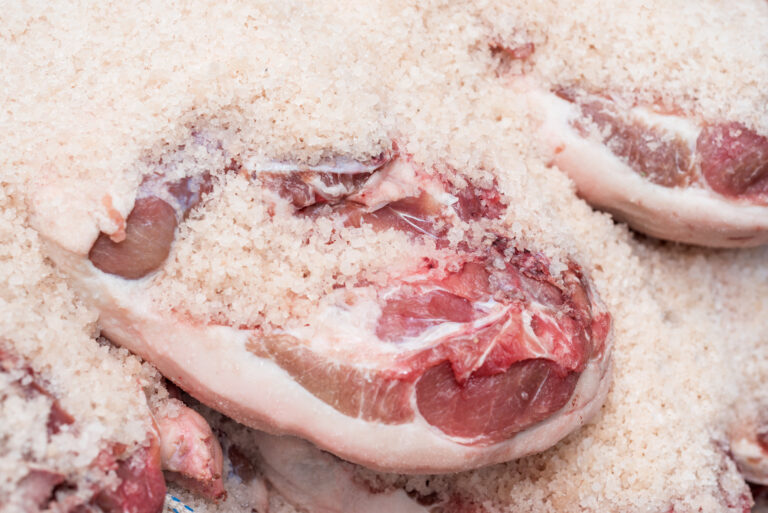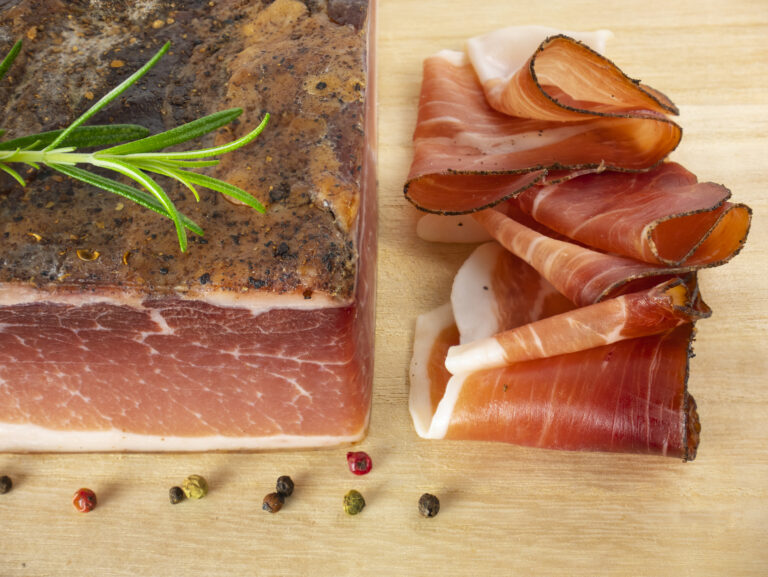5 Charcuterie Meats You Need to Try for a Perfect Platter
Charcuterie is more than a platter of cured meats; it’s an art form with a rich history. From hams to salami to pâtés, explore the world of charcuterie meats and create flavorful platters with a variety of ingredients.

Nowadays, charcuterie refers to the collection of cured and smoked meats on a platter, but it’s so much more than that. It’s an art form designed to preserve meat without refrigeration.
Like any art form, it has evolved over a matter of centuries and has many iterations, from salami to pâté to various kinds of sausages.
Despite being a food tradition that goes back hundreds, if not thousands of years, charcuterie has worked its way back into popular consciousness of late, thanks in large part to social media.
Disclosure: As an Amazon Associate, this site earns from qualifying purchases. Thank you!
What Are Charcuterie Meats?
The short answer is, it depends. In the broadest sense, charcuterie meats can include any type of cured or preserved meat. Technically, you don’t even have to serve different meats together on a platter. It can be just one type of meat.
However, a platter filled with a variety of meats on it is what many people think of when they think of charcuterie today.
Additionally, even in France, where the term charcuterie originated, the types of meats served on a charcuterie platter vary from region to region, depending on what’s available.
This is a lesson for home food crafters: If you’re making a charcuterie platter to serve at a party or ordering one as an appetizer in a restaurant, you’ll encounter an amazing array of flavors and meats.
Some of those flavors come from the meats you choose for the platter. Others will come from other ingredients.
If you’re shopping for ingredients to make your own, the list below offers you some tips for choosing not only charcuterie meats but also “accent” flavors to go with the meats.
Hams, Pastrami, and Other Salt-Cured Meats

In France, some version of ham often makes an appearance on charcuterie platters. Jambon de Paris, a type of ham that includes only salt as a flavoring, finds favor with many charcuterie home food crafters.
Because it only includes salt as a flavoring, the meat itself must be high quality to give it the best flavor.
There is also a cured ham, called Jambon de Bayonne, which finds its way to many a charcuterie platter (similar to Spanish cecina).
All of this said it’s also okay to include a variety of hams found in the local deli. Honey ham, salt-cured ham, and plain boiled ham are fair game when it comes to assembling your platter.
And speaking of prosciutto, it’s also acceptable to include foods that aren’t traditionally French on a charcuterie plate. Pastrami also adds a bit of salty flare to a charcuterie board.
Fermented Meats: Salami

Salami represents a traditional Italian fermented meat, usually made from pork or beef. Salami makers stuff ground pork or beef into casings, along with animal fats and a variety of seasonings to give the meat flavor. These meats are then hung up to encourage the fermentation process.
The preservation process includes “hanging time,” which allows the fermentation process to take place. If the meat has spent a lot of time in the fermentation process, it turns out dryer than salamis that spend less time in the fermentation process. It is also great on sandwiches in addition to simple charcuterie boards.
Mousses and Pâtés

Pates mix together meat, seasonings, and fat that are ground up and then cooked in a mold. Vegetables often make an appearance in some pates as well.
Pates and mousses allowed cooks to use all the parts of the animal in the preservation process, including offal (organs and entrails) and the fat from the animal. Almost any type of animal meat can be turned into a pate or mousse.
Mousses typically have a finer texture than pates. Often, pate makers use liver to create this dish.
Fish

In the early days of the US’s history, smoked fishes, like salmon or trout, became a popular dietary staple for the same reason that pork was popular in places like Germany and France in pre-modern times: It was available.
According to the Spruce Eats, lox, a popular form of cured salmon, started to gain popularity in the early 1940s. Pacific salmon provides lox manufacturers with the meat for lox. Lox is typically served on bagels with cream cheese and peppercorns.
That said, other types of smoked salmon (and smoked fish in general) exist. Epicurious states that smoked fish is created by first, curing it with salt or in brine, and then, putting it in the smoker.
Smoked meats bring a different flavor to a simple charcuterie platter and are nice to include in the mix.
What Are Charcuterie Meats: Other Options

It’s probably safe to say that most people associate charcuterie meats with deli meats. As such, any number of meats may end up on a charcuterie platter.
Salami, turkey, duck, jerky of all sorts, and rabbit add flavors to the charcuterie platter.
Essentially, the spirit behind charcuterie was to preserve meats and not let anything go to waste. In light of that, if you’re assembling a charcuterie platter at home, it’s okay to use up the extra ingredients you have in the refrigerator by putting them on a charcuterie platter.
Food historian Sarah Wassberg Johnson reminds charcuterie enthusiasts that it’s okay to bring modern sensibilities to this traditional dish.
While modern eaters hunt store aisles for exotic tastes to make a proper charcuterie tray, the reality is, this attitude represents a modern practice.
Originally, charcuterie represented regional foods. While one region may have been known better for pork, another region may have developed a reputation for an abundance of beef.
More plainly, the meats that made up charcuterie were the meats common to that region. If pork was common, then pork became the charcuterie meat of choice. If beef was common, then it became the meat of choice.
Other Charcuterie Ingredients

Cheeses and Eggs
Cheeses, like brie, feta, mozzarella, cheddar, and more add creaminess and sometimes, tanginess to the charcuterie platter (especially if you mix in a goat cheese along with a soft cheese).
Deviled eggs bring both creaminess and an interesting array of colors to the platter. A nice cheese board or cheese platter makes a good visual complement.
Pickles, Olives, and Other Vegetables
Pickles and olives add a salty and sometimes, savory flavor to a charcuterie platter. For variety, include different kinds of olives, like Greek olives and black olives.
While pickled cucumbers represent a popular pickle option for these plates, other pickled vegetables, like carrots, asparagus, onions, and cauliflower add different textures and flavors to the platter.
Fruit and Nuts
Fruits and nuts lend both a sweet and sometimes, exotic element to your platter. Although grapes represent a popular fresh fruit choice, you don’t have to limit your platter to that.
Fresh figs, persimmons, dates, strawberries, and star fruits create both a sweet and exotic vibe and bring in the sweet element of the recommended flavor combinations. Dried fruit is a nice touch as well.
Nuts can also be sweet, but many are spicy or salty, too. Additionally, nuts offer a different textural element to a charcuterie platter. Walnuts, pecans, almonds, Brazil nuts, pistachios, and even peanuts are fair game.
Bread, Crackers, and Dips
It’s hard to imagine a modern charcuterie platter without little slices of bread (especially a sliced baguette), an assortment of salty and savory crackers, and mouth-watering dips and sauces.
These elements add so many different textures and flavor elements to a plate, making it not only more visually interesting but more interesting to the taste buds, too.
Good options include slices of French or Italian bread, baguettes, bagels, pumpernickel, table water crackers, and sweet crackers.
As for dips, cheese dips, like a savory cream cheese dip, hummus, and onion dips, as well as sweet dips for the fruit, like sweetened cream cheese or melted chocolates represent popular fare. Cookies aren’t traditional, but can be popular as well.
FAQs on Large Charcuterie Boards
Did charcuterie exist before the 15th century?
Sort of. The word charcuterie specifically references a type of meat seller in 15th-century France. This person sold dried, cured, and smoked meats and then advertised them by hanging them in his shop window.
That said, charcuterie in the broadest sense also references cured, dried, smoked, or preserved meats of any kind. Humans have preserved meat for more than 40,000 years, according to evidence found in cave paintings.
It’s also important to note that often people refer to any processed meat as cured meat. The terms are used interchangeably. The processing of curing meat and other foods means these foods have a longer self-life because they’ve been treated with something or put through some process.
Why did people cure meat and create charcuterie?
It’s difficult to comprehend how much refrigeration changed human eating habits. While there were some natural methods of refrigeration throughout the centuries, refrigeration as a means of food preservation as we know it today didn’t really hit the food history timeline until about 1830, according to History Magazine.
Until that time, people used food preservation processes that were easier to access, including smoking, curing, fermentation, and the like.
Why is social media so important to the evolution of modern charcuterie?
Modern charcuterie includes vibrantly colorful craft cured meats, tangy cheese, succulent fruits, and fancy bits of bread. Because these platters look so visually appealing, they get a great deal of attention on social media sites, like Instagram and Pinterest, according to the Business Insider.
This has a great deal to do with the explosion of colors and textures found on the common charcuterie platter.
But beyond the visual appeal of these snack meals, the principle behind them also appeals to home cooks. This food trend arose out of a larger trend. That is, people love to create craft foods and beverages at home.
Charcuterie only accounts for one kind. There are also people who create items, like craft beers, for example. These types of hobbies are all part of the craft food movement.
Are there vegan and vegetarian charcuterie boards?
It’s most accurate to say that a version of the idea of charcuterie exists in the vegetarian and vegan communities since charcuterie is technically cured meat. That said, because you can now find vegetarian and vegan versions of foods, like salami, mushroom jerky, ham, pepperoni, and turkey (to name but a few), it’s now possible to assemble these foods on a platter to create a vegetarian version of this snack favorite.
These platters can also include dips, like hummus, peanut butter, or honey mustard. Olive and pickles add a salty flare. Vegan cheeses and spicy dips bring in the spicy and savory aspects of the platter. Also included are breads and crackers or fresh vegetables for dipping.
How can I find ingredients for my charcuterie platter?
Take a foodie tour of most towns nowadays, and you’re likely to run into some sort of specialty food store or deli. These stores represent the most logical (though pricey) place to find the necessary ingredients for these types of platters, at least from a local standpoint.
Additionally, the Internet truly opened up the world to people. It’s now possible to order specialty ingredients from just about any place in the world, including dried and cured meats.






